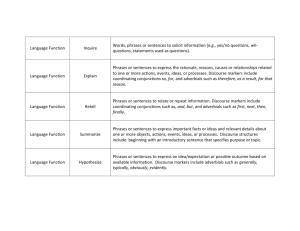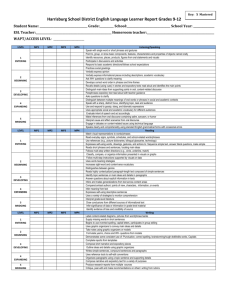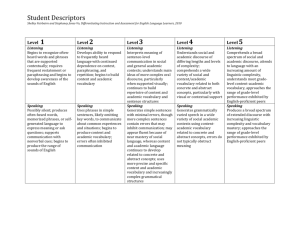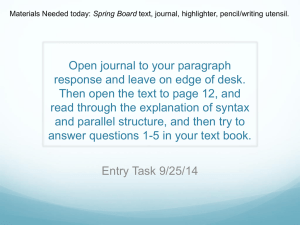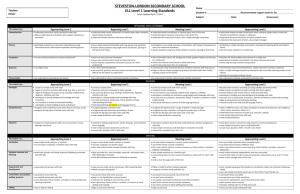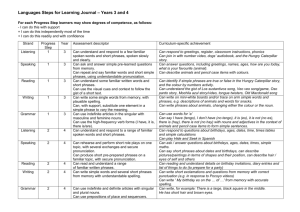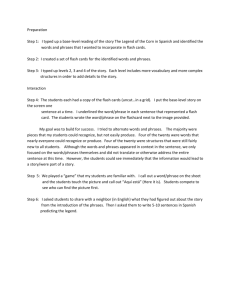Absolute phrases
advertisement
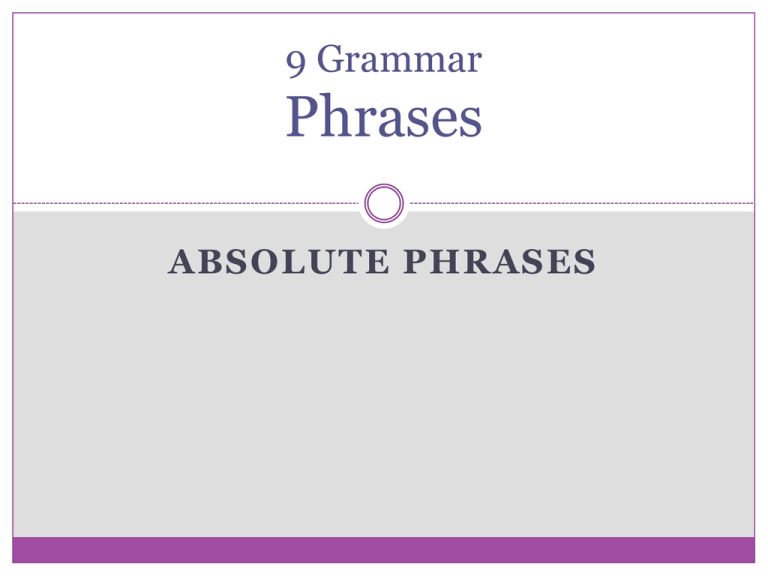
9 Grammar Phrases ABSOLUTE PHRASES Phrase A phrase is a group of words, without a subject and verb, that functions in a sentence as one part of speech. Absolute Phrases An absolute is made up of a noun and its modifiers Absolutes function as adjectives in a sentence An absolute allows us to move from a description of a whole person, place, or thing to one aspect or part Absolute Phrases High in the air, a little figure, his hands thrust in his short jacket pockets, stood staring out to sea. (Katherine Mansfield, “The Journey”) Absolute Phrases Absolutes are almost complete sentences As a test, you can make any absolute a sentence by adding was or were The absolute phrase provides some sort of information that works to put the whole sentence or idea in context - they modify entire sentences Absolute Phrases She returned to her bench, her face showing all the unhappiness that had suddenly overtaken her. Theodore Dreiser, An American Tragedy CHECK - Her face was showing all the unhappiness that had suddenly overtaken her. Punctuating Absolute Phrases Absolute phrases are optional in sentences and can be removed without damaging the grammatical integrity of the sentence. Since absolute phrases are optional in the sentence, they are often set off from the sentence with commas or, less often, with dashes. Improve your Writing Absolutes show a special "how" relationship between two sentences. The two sentences are combined in a way that subordinates one to the other. Mary was sitting at her desk. Her head was slightly lowered over a pile of chemistry notes. Mary was sitting at her desk, her head slightly lowered over a pile of chemistry notes. Improve your Writing Check to see if there is a "be" verb in the sentence you can subordinate, eliminate it and combine the sentences with a comma. Julie accepted the award. Tears were streaming down her face. Julie accepted the award, tears streaming down her face. Improve your Writing If there is a "possessive" relationship between the two sentences, use possessive pronouns (its his, their, etc.) to indicate the relationship between the subjects ** Absolute phrases often begin with possessive pronouns The cat confronted the burglar. It arched its back and bared its teeth. The cat confronted the burglar, its back arched and teeth bared. Improve your Writing Number singular Person Gender (of "owner") Possessive Pronouns 1st male/female my 2nd male/female your male his female her neuter its 1st male/female our 2nd male/female your 3rd male/female/neuter their 3rd plural Improve your Writing Absolute phrases can be used as sentence openers, subject-verb splits, or sentence closers. His hands raw, he reached a flat place at the top. (Richard Connell, The Most Dangerous Game”) Miss Hearne, her face burning, hardly listened to these words. (Brian Moore, The Lonely Passion of Judith Hearne) He walked with a prim strut, swinging out his legs in a half-circle with each step, his heels biting smartly into the red velvet carpet on the floor. (Carson McCullers, “The Jockey”) Improve your Writing Although many absolute phrases could be written with the word being or the words having + PAST PARTICIPLE in them, formal English does not to use being when being is optional The movie being over, we left the theater. The movie over, we left the theater. Having been chosen to head the committee, Angus Ng thought about how he could help raise money for his chess club at Harvard. Chosen to head the committee, Angus Ng thought about how he could help raise money for his chess club at Harvard.


